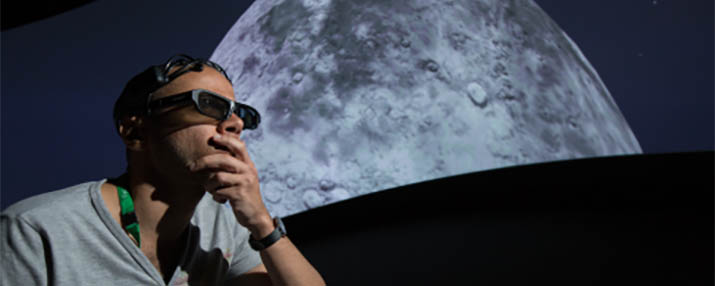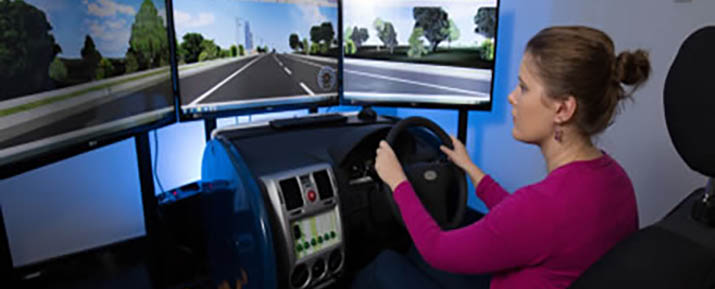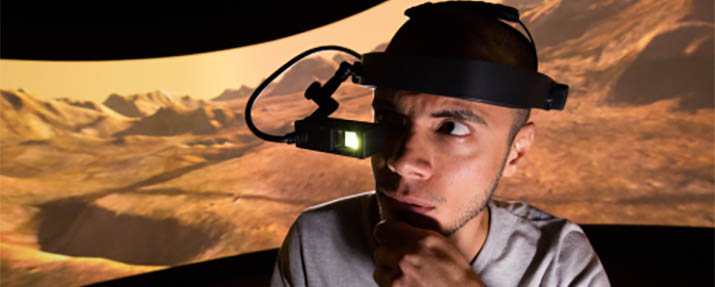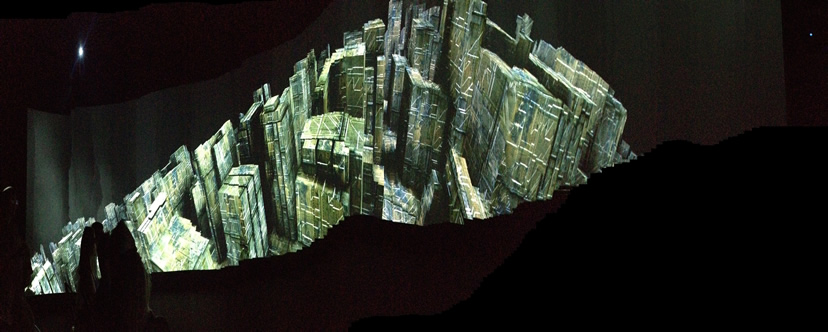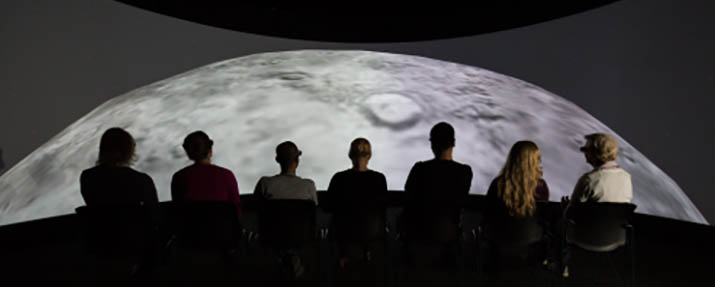Our projects
Our Projects
Our research group works on designing futuristic interfaces for human-computer interaction. We use a number of Virtual reality tools, such as datagloves, face trackers, motion trackers, motion capture suit, stereoscopic goggles. These systems will allow us to use todays' computers with less effort, making the interface as transparent and ubiquitous as possible. The idea is there won't be a computer anymore that you will communicate with, there will be a ubiquitous system. You will use your natural speech, gesture, facial animations to communicate with them and future's computer systems will be able to sense your emotions and engagement in task performance
Our research projects are driven by grants and fellowships obtained by academics and scholarships obtained by PhD students, as well as self-funded postgradute projects led by Master of Research, Master of Engineering and Master of IT students.
VISOR Obtains Research Funds
VISOR members obtained 28 grants in total (20 research grants, 2 teaching grants, and 6 strategic infrastructure grants). We held four successful ARC projects in the area of HCI: two ARC Discovery Grants (DP0988088 and DP0558852) and two ARC Linkage grants (LX0560117 ARC Linkage International Fellowship, and LP0216837 ARC Linkage Grant) that involved international collaboration as well as collaboration with industry. In these grants, we have delivered innovative systems using cutting edge technologies and analysing system requirements. The Major focus of the group is to apply the research findings to the design and implementation of interactive systems such as Virtual Reality and Computer Games and test the usability of such systems through experimental analysis.
VISOR Trains Researchers in VR
VISOR members have trained over 49 research associates in VR, supervised 7 Postdocs, 11 PhD, 9 MEng, 2 MSc, 18 MIT and 7 Honours students. A/Prof Kavakli is currently supervising 6 PhD students. In these theses, we have developed techniques for engineering of virtual reality systems, including a range of simulations, as well as methods for motion tracking and emotion detection from speech. We are leaders in Interactive System Development, User Interface Design, and Cognitive Modeling.
VISOR Brings Together Researchers
We have had members from several different universities in Australia and worldwide and continue our collaboration with these institutes. In past, we had 21 researchers visiting from a wide range of countries (Sweden, Denmark, USA, Poland, India, Italy, France, Belgium, Germany, Turkey, Switzerland, and Britain.) We believe that cultural diversity is the strength of Australia that brings us philosophical richness in the methods that we use.The group currently has strong links with The Virtual Immersion Research Group, Image Institute - Laboratory Le2i, ENSAM, Arts et Métiers ParisTech, Chalon Sur Saone, France. A/Prof Manolya Kavakli visited ENSAM as a research professor 3 times in the last 4 years and supervised 9 internship projects of MEng students visiting us from various institutes in France.
Current VISOR PhD Projects
- MRes + PhD Thesis on an Augmented Reality Simulation using Motion Tracking, Ali Fahim Khan, Master of Research as a Pathway to PhD)(Provisional) (2016-2017) 44709862 International Research Training Pathway(iRTP) scholarship for the MRES program with a possible International Macquarie University Research Excellence (MQRES) scholarship for PhD program, 1 July, 2016 (Ass Supervisor: Len Hamey)
- MRes+ PhD Thesis on Contextually -aware Patient Activity Monitoring forHeart Disease, Hamed Saleh D. Alqahtani, Department of Computing, Macquarie University, Sydney, Australia (s2 2016-2019) [Associate Supervisor:RajanShankaran, Melissa Norberg]
- MRes + PhD Thesis on TheAge of the Aboriginal Avatar, Kevin Lucas, Department of Computing, Macquarie University, Sydney, Australia (2016-2020) to apply in January 2016 Indigenous Scholarship [Principal supervisor: Karen Perlman]
- MPhilY1+PhD, Aydin Tajer, Department of Computing, Macquarie University, Sydney, Australia (2016-2021) to start in January 2016s2
- PhD Thesis on Motor Imagery Based EEG Signal Classification using Deep Learning Algorithms, Muhammad Zeeshan Baig Department of Computing, Macquarie University, Sydney,Australia (2015-2018) to apply in August 2015,International Macquarie University Research Scholarship (iMQRES) 44699956, commencing in Semester 2, 2016, scholarship allocation number 2016040, (Ass. Supervisor: Len Hamey, Dr Melissa Norberg)
- PhD Thesis on Building Information Modeling, Shaghayegh Askari, applied on 21.10.2014, accepted on 26.02.2015 [Associate Supervisor Stephen Smith] started on 23 Feb2016- 23 February, 2019, 43929982
- PhD Thesis on Overview of human factors issues inremotely-piloted aircraft operations, Peter Renshaw, Department of Psychology, [Principal Supervisor Mark Wiggins, Associate Supervsior Manolya Kavakli until 2016s2)2015
- PhDThesis on Energy Monitoring Through Social Mobile Applications, Majed ALROWAILY (43846416) [Associate Supervisor Dr Rajan Shankaran, External Supervisor Prof Stephan Bohm] (25.Feb.2015-2018) Saudi Arabian Cultural Mission Scholarship
- PhD Thesis on Motor Cognition and Agents using Cognitive Robotics for Interactive Navigation with An Adaptive Virtual Environment Interface,Zhenzhong (Charles) Liu,43874339, 2015 International Postgraduate Research Scholarship (IPRS) upgraded from International Macquarie University Research Scholarship (iMQRES) [Associate Supervisors Prof Ken Cheng & Dr Scott Mc Callum, External Supervisor Jean-Remy Chardonnet] (2015-2018) (1st place in the Department Final for The Faculty of Science Final of the 2015 3 Minute Thesis Competition on Tue September 15th, 12pm – 2015 3MT Competition (Faculty Final) – W5A Price Theatre)
- PhDThesis on A research on a new myoelectric control systemfocused on developing accurate pattern classification and Signal Processing System for an affordable prosthesis, Hessam Jahani FARIMAN, 43880878, International Macquarie University Research Scholarship (iMQRES) [Associate Supervisor Len Hamey, External Supervisor Prof Frederic Merienne] (3.3.2015- 3 March 2018)
- PhD Thesison Optimisation of Cognitive Load in Driving Simulators controlling MotorSkill Acquisition & Augmented Feedback , Hasan Alyamani, Department of Computing, Macquarie University,Sydney, Australia, [Associate Supervisor StephenSmith, External Supervisor Prof Andras Kemeny] (2014-2017)(23.11.2014-23.12.2017) Saudi Arabian Cultural Mission Scholarship
- PhD Thesis on The Role of Augmented Reality to manage perception, memory recall, and Cognitive Load and thereby improve Decision Making & Motor Skills, David Walker,Department of Computing, Macquarie University, Sydney, Australia(2013-2018) (1st place in the Department Final and 3rd place in The Faculty of Science Final of the 2014 3 Minute Thesis Competition on 23rd July 2014) [Associate Supervisor Prof Mark Wiggins] [due on 11.3.2021]
- MResY2+PhD Thesis on Scenario Engineering, Tasmiha Salam, Department of Computing, Macquarie University, Sydney, Australia (2017-2020) to startin January 2017 (Ass Supervisor: Len Hamey)
- MRes + PhD Thesis on Sketch Recognition in Virtual Reality, Soheila Sadegiram, Department of Computing, Macquarie University, Sydney, Australia (2016-2020), iMQRES Round Notification (Master of Research as a Pathway to PhD) (Provisional)- 44710526 (Ass Supervisor: Len Hamey) 2016s2
- MPhil+PhD Thesis on Evaluating the Effectiveness of Augmented and Virtual RealityModel for Students, Learning outcomes (Virtual Instructor: Development ofan Adaptive System Using VR and AR), Muteeb Saad Alahmari, Department of Computing,Macquarie University, Sydney, Australia (2016-2019) to apply in August2015, applied on 5th Sep 2015, Saudi Arabian Cultural Mission Scholarship (Ass. Supervisor: Len Hamey)
- MRes + PhD Thesis on Human-Avatar Interaction in Stress Management using mobile programming and psycho physiological feedback devices ,Amin Shahraki Department of Computing, Macquarie University,Sydney, Australia (2016-2020), iMQRES Round Notification (Master of Research as a Pathway to PhD) (Provisional) [Principal Supervisor: Rajan Shankaran, Associate Supervisor: Manolya Kavakli]
- PhD Thesis on VirToile: Development of a ubiquitous Stereoscopic system for 3Dmodelling and assembly design in engineering, Mutahir Hafeez, Department of Computing,Macquarie University, Sydney, Australia (2015-2018) to start in Jan 2017, applied on 31st Oct 2014 (no scholarship)
Completed VISOR Projects
PhD Projects
- PhD Thesis on Analysis of Gender Differences in Speech and Hand Gesture Coordination for the design of Multimodal Interface Systems, Jing Liu, E-IPRS (Endeavor-IPRS) Scholar, Macquarie University Research Excellence Scholarship (MQRES) Scholar, Department of Computing, Macquarie university, Sydney, Australia (2009-26.6.2014)
- PhD Thesis on “Understanding Computer Graphics Student Problem Solving through Source-Code Analysis”., Maximillian Wittmann, MQRES Scholar, Department of Computing, Macquarie university, Sydney, Australia (2008-2013)
- PhD Thesis on Facial Expression Classification Using Optical Tracking, Wavelet Filters and Subspace Learning Method, Yi Fan Gao, Department of Computing, Macquarie university, Sydney, Australia (21.2.2005-4.6.2013)
- PhD Thesis on Psychological Rehabilitation using VR, Eric Malbos Department of Psychology, Macquarie University, Sydney, Australia (2008-2012) (as an Associate Supervisor)
- PhD Thesis on Simulator Sickness, Susan Bruck, Department of Computing, Macquarie University, Sydney, Australia (2006-2012) (as an Associate Supervisor)
- PhD Thesis on The Visual Complexity of Instructional Animations in Training Simulations to Promote Learning: Guidelines for Virtual Reality Designers, Iwan Kelaiah (Kartiko), ARC Scholar, Department of Computing, Macquarie University, Sydney, Australia (30.3.2007-24.12.2011)
- PhD Thesis on The Emergent Behaviour of Self Replicating Machines, Antonio Lafusa, IMURS1 Scholar, Department of Computing, Macquarie University, Sydney, Australia (2005-2009)
- PhD Thesis on Collaborative Learning Environments, Eric Fassbender, Department of Computing, Macquarie University, Sydney, Australia (2006-2009) (as an Associate Supervisor)
- PhD Thesis “Body Machine Interface – Remapping Residual Mobility of Spinal Cord Injured patients to Control Assistive Robotic Devices”, Tauseef Gulrez, RAACE Scholar, Department of Computing, Macquarie university, Sydney, Australia (27.7.2006-2008)
- PhD Thesis “Play Story, Communication, Character, and Cross-platform Gaming Experiences in Multi Player Role Playing Games”, Anders Tychsen, IMURS1, IPRS, HDRSCHOL Scholar, Department of Computing, Macquarie university, Sydney, Australia (1.1.2005-31.12.2008)
- PhD Thesis “Emotion classification and Analysis in the Design and Implementation of a Game Pidgin Language”, Tarashankar Rudra, APAI - ARC Scholar, Department of Computing, Macquarie University, Sydney, Australia (2002-2008)
- MSc Thesis on Biometrics, Zheng Zhou, Department of Computing, Macquarie university, Sydney, Australia (2005-2007) (as an Associate Supervisor)
- M.Sc. Thesis on Computer Supported Collaborative Design Models at a Distance in Architecture, Taluy Denizhan Petuhova, Dept. of Architectural Design, Institute of Science & Technology, Istanbul Technical University (1997-1999)
Honours Projects
- Ben Phelan, Modelling Emotion for the Development of a Virtual Human: Facial Asymmetry During Expression (2007-2008) (2nd Honours), Department of Computing, Macquarie university, Sydney, Australia
- Eric Dalglish, An Investigation into the Effects of the Addition of Photosensors to Self Replicating Robots (2007-2008) (1st Honours), Department of Computing, Macquarie university, Sydney, Australia
- Max Wittmann, CART: A Virtual Environment for Cognitive Experiments (2006-2007) (1st Honours), Department of Computing, Macquarie University, Sydney, Australia
- Dilmi Palliyaguruge, Gait Recognition and Motion Capture as a Precursor for Behavioural Biometrics (2005-2006) (1st Honours), Department of Computing, Macquarie university, Sydney, Australia
- Dilshan Wadu Jayarathna, 3D Sketching in Virtual Reality (2004-2005) (1st Honours), Department of Computing, Macquarie university, Sydney, Australia
- William Tsoi, Modelling Risk and Strategies in Gameplay (2004) (2nd Honours), Department of Computing, Macquarie university, Sydney, Australia
- Yi Fan Gao, Crime Prevention Through Environmental Design in Virtual Reality (2004) (2nd Honours), Department of Computing, Macquarie university, Sydney, Australia
Master of Engineering Projects
- Nolwenn Bigoin, Motion Sickness and Digital Content, AIX,Marseilles, France, 2007.
- Stephane Piang-Siong, Designing in Virtual Reality, ENSAM,Paris, France, 2008.
- Joris Boulloud, Virtual Immersive Collaboration, ENSAM, Paris,France, 2009.
- Edouard Domenjoud, Gesture Recognition in Virtual Reality,ENSAM, Paris, France, 2010
- Benoit Salle, Gesture Recognition in Virtual Reality, ENSAM, Paris, France, 2011
- Quentin Bellego, ENSAM, Paris, France, 2011
- PierreEtienne-Dandaleix, ENSAM, Paris, France, 2012
- Nan Jin, AIX,Marseilles, France, 2015
MIT Projects
- Terry Black, iBeacons in Mobile Computing, IT Project Report, Macquarie University, June2014
- David Coucke, Integration of Speech and Hand Gestures in Multimodal System Development, IT Project Report, Macquarie University, Nov 2013
- Daraksha Binte Hussain, Analysis of Design Gestures, IT Project Report, Macquarie University, Nov 2013
- Hedieh Ranjbartabar, ESCAP, IT Project Report, Macquarie University, June 2013
- Yara Aljahani, E-Commerce in Saudi Arabia, IT Project Report, Macquarie University, June2013
- Edgar Enrique Blanco Ascanio, AR-CORP, IT Project Report, Macquarie University, June2013
- Yan Chen Gesture Analysis and Gender Differences, IT Project Report, Macquarie University, November 2012
- Amir Maddah, User scenario Engineering, IT Project Report, Macquarie University, November 2012
- Karime Nasser Alvarez, Gesture Analysis and Intercultural aspects, IT Project Report, Macquarie University, November2011
- Saif Said, Gesture Recognition and Analysis in Virtual Reality, IT Project Report, Macquarie University, Nov 2011
- Tayeef Mahmood, Cognitive Load, IT Project Report, Macquarie University, November 2011
- Sergio Alejandro, Cognitive Load in Learning Computer Graphics, IT Project Report, Macquarie University,November 2010
- Kevin Zodros, 'Effect of digital content on motion sickness in a virtual environment with semi-cylindrical screen and stereoscopic goggles' IT Project Report,Macquarie University, November 2010
- Yilun Li, 'Investigating the high frequen</li>cy camera movements(cinematography) in simulator sickness during 3D TV exposures' IT Project Report, Macquarie University, November 2010
- Wen Cao, 'Depth perception and the investigation of simulator sickness in 3D TVs', IT Project Report, Macquarie University, November 2010
- Norman Koester, An Extension of the Gesture Recognition System Pro-MOTE for the use in the Area of Scientific Collaboration, IT Project Report, Macquarie University, June 2010
- Alexey Novoselov, Wearable Sensor Analysis for Gesture Recognition, IT Project Report, Macquarie University, November 2009
- Shweta Jain, 3D Interactive Whiteboard for Scientific Collaboration, IT Project Report, Macquarie University, June2009
Funded VISOR Projects
RESEARCH GRANTS AWARDED
- 2014-2015 - MQSIS Grant, Strategic Infrastructure Scheme, (Audiology, Linguistics, Psychology, Computing, Centre for Emotional Health, Institute of Early Childhood, ACG) (McMahon,Kruger, Wiggins, Kavakli, Benson, Kruger, Newhall, Stephen, Hellmann) Cognitive processing: Eye tracking and EEG ($97K)
- 2013-2014 - MQSIS Grant, Strategic Infrastructure Scheme, Virtual Reality Dome System, Departments of Psychology,Chiropractics, Computing, and Media, Macquarie University, Centre for Human Performance Simulation ($880K) (Mark Wiggins, Kim Curby, Manolya Kavakli-Thorne, Andrew Baillie, Julia Irwin, Melissa Norberg, Bill Thompson, Kat Mills, Greg Downey)
- 2014-2015 - Macquarie University Faculty Equipment Grant, Portalite Near Infrared Tissue Oxygenation Monitor, Faculty of Human Sciences, Faculty of Science (Depts of Psychology, Computing, Medicine) (Wiggins, Thompson, Norberg, Baillie, Curby, Kavakli, Wood, Irwin) ($10K)
- 2012-2013 - Enterprise Partnership Grant, Macquarie University (Kavakli & Love) Enhancing learning outcomes using immersive technologies and training simulations in critical decision making and emergency management in Sydney Ferries ($40K) –[called off due to privatization of S.Ferries]
- 2012-2013 - Macquarie University Safety Net Grant (Kavakli) for DP120103004
- Authoring Training Simulations for First Responders ($25K)
- 2010-2011 - Research Infrastructure Block Grant (Wiggins, Thompson, Kavakli, Jones, Hall) 9201001581
- Proposed Purchase of A Redbird FMX Flight Simulator for Macquarie University ($75K)
- 2010-2011 - Research Infrastructure Block Grant (Richards, Thompson, Kavakli, Evans, Crowdy, Hitchens) 9201001566
- An immersive virtual reality environment for sound and vision experimental studies ($31K)
- 2009-2012 - Australian Research Council Discovery Grant, DP0988088 (Kavakli)
- A Gesture-Based Interface for Designing in Virtual Reality ($220K)
- 2008-2010 - Macquarie University Research Development Grant (Gilchrist, Twamley, Kavakli) (50K) Immersive Virtual Scientific Collaboration
- 2007Strategic Infrastructure Scheme, MQSIS, Division of Information & Communication Sciences, Macquarie University ($38K)
- 2006-2007 - Macquarie University Safety Net Grant (Kavakli, Hitchens)(8K)
- Modelling and Enhancing Interaction in Computer Games and Interactive Entertainment
- 2006 - Macquarie University New Staff Grant (Kavakli)
- Gesture Recognition and Motion Capture as a Precursor for Behavioral Biometrics ($19K)
- 2006 - Macquarie University Safety Net Grant (Kavakli)
- Face Identification using Haptic Interfaces ($19K)
- 2005-2006 - Research Infrastructure Block Grant (Kavakli, Watters, Richards, Szilas, Burke, Leslie)
- Virtual Reality Engine ($58K)
- 2005-2008 - Australian Research Council Discovery Grant, DP0558852 (Richards, Kavakli, Dras)
- Risk Management Using Agent Based Systems, Macquarie University ($362K)
- 2005-2006 Safety Net Grant, Macquarie University (Kavakli)
- Face Detection Through Sketching in Virtual Reality ($19K)
- 2005-2006 - Australian Research Council Linkage International Fellowship, LX0560117 (Kavakli, Pelachaud, Szilas)
- Interactive Drama Engine in Virtual Reality, Macquarie University ($71K)
- 2004 - ICS Research Startup Grant, (Kavakli), Interactive Sketching in Virtual Reality, Macquarie University ($6K)
- 2002-2005 - Australian Research Council Linkage Grant, LP0216837 (Kavakli, Bossomaier, Tien, Cooper), Cognitive Modeling of Computer Games Pidgins ($75K)
TEACHING GRANTS AWARDED
- 2008 - Macquarie University Teaching Equipment Grant (Hitchens and Kavakli) ($75K)
- Computer Graphics and Virtual Reality Teaching Laboratory
- 2008 - Macquarie University ICS Teaching Development Grant (Kavakli) (2.5K)
- Development of a Learning Platform Using Virtual Reality (VR) and Knowledge Engineering methodologies as a Precursor for an Intelligent VR Trainer
OTHER GRANTS AWARDED
- 2006 - Immersive Projection Screen, Strategic Partnership with VR Solutions, Macquarie University ($600K)
- 2003 - Major Equipment Grant, Division of Information & Communication Sciences, Macquarie University ($90K)
Other Projects
Impact of Animated-Virtual Actors on Learning
Investigating the impact of Animated-Virtual Actors (AVAs) and learning outcomes in Virtual Reality (VR) applications. As the technology in computer graphics accelerates, so does visual complexity in VR applications. However, the question is: "Does it benefit learning?"
Speech and Emotion Recognition using Pidgin Languages
We have developed a pidgin language to communicate with game characters in a computer game. We also found thresholds to detect the emotions in the spoken words of this pidgin language. Thus, in future we will be able to speak to our computer and the computer will be able to understand our emotions, evaluating these thresholds.
Measuring Engagement using Biometrics
We have developed a virtual reality training simulation. The training simulation displays a world on a 6m wide semi-cylindrical stereoscopic immersive projection screen (like IMAX). Now, our purpose is to measure users' engagement with the task, when they are training in a virtual environment, using a number of biometric devices, such as EEG, ECG, EGG, etc.
Robotics Wheelchair
We have developed a robotic wheelchair for quadriplegic people so that they can operate a wheelchair using their redundant body signals such as the muscles at their back and shoulders. We can get this input through a sensor jacket. We use the semi-cylindrical stereoscopic immersive projection screen for training the patient in operation of the robotics wheelchair. Robotics wheelchair is semi-autonomous, and may take the control over, if necessary.
Gesture Recognition
We have developed a gesture recognition system to communicate with computer generated characters (agents) in a training simulation. This will allow the agents to interpret your gestures, and act accordingly. We will integrate a motion tracking system, motion capture suit, data gloves, with an immersive projection screen in this project.
Facial Animations and Emotion Recognition
Face tracking is a technology we use to capture facial animations of a person. We use this to detect the mood of a person. The computer may sense the emotions of a person evaluating the emotional thresholds of being neutral, angry, or happy. The animations, later, can be used for animating any face by matching it onto a 3D face model in a database.
Face Reconstruction via Virtual sculpting
This is an interface for forensic artists, designed to help them carve the face of a criminal, using a pair of data gloves and a stereo display. The interface will present a 3D generic face model to the forensic artist. The forensic artist will be able to sculpt the criminals face using this generic face model as a basis, getting the comments of an eye witness. Later, the resultant face model will be matched to the facial models in a face database.
More Projects:
- Gesture Recognition and Motion Capture as a Precursor for Behavioral Biometrics (2006)
- Face Detection through interactive sketching in virtual reality (2005)
- Face Identification using Haptic Interfaces (2006)
- Cognitive Modelling in Computer Game Pidgins (2002-2005)
- Hands as Dynamic Input Devices for Interactive 3D Sketching & Modelling Within Virtual Reality (2004)
- An Interactive Drama Engine in Virtual Reality (2005-2006)
- Risk Management using Agent-Based Virtual Environments (2005-2007)
- Virtual Reality Engine (2005-2006)

